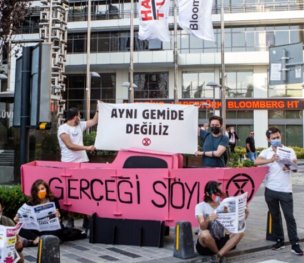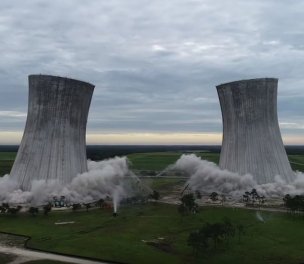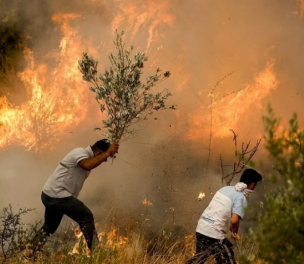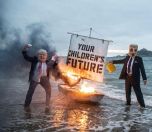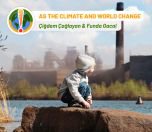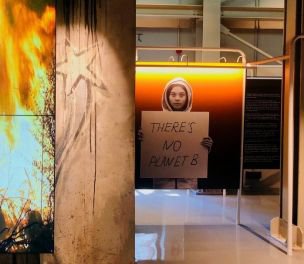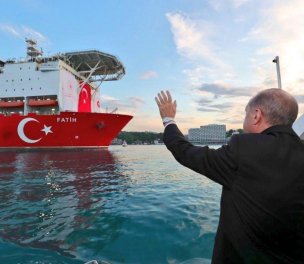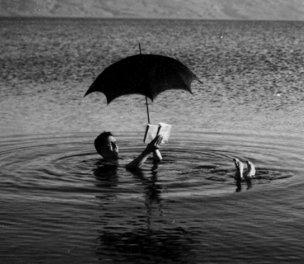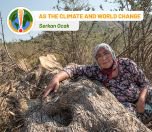AS THE CLIMATE AND WORLD CHANGE - 8
Bringing science, struggle, and art together
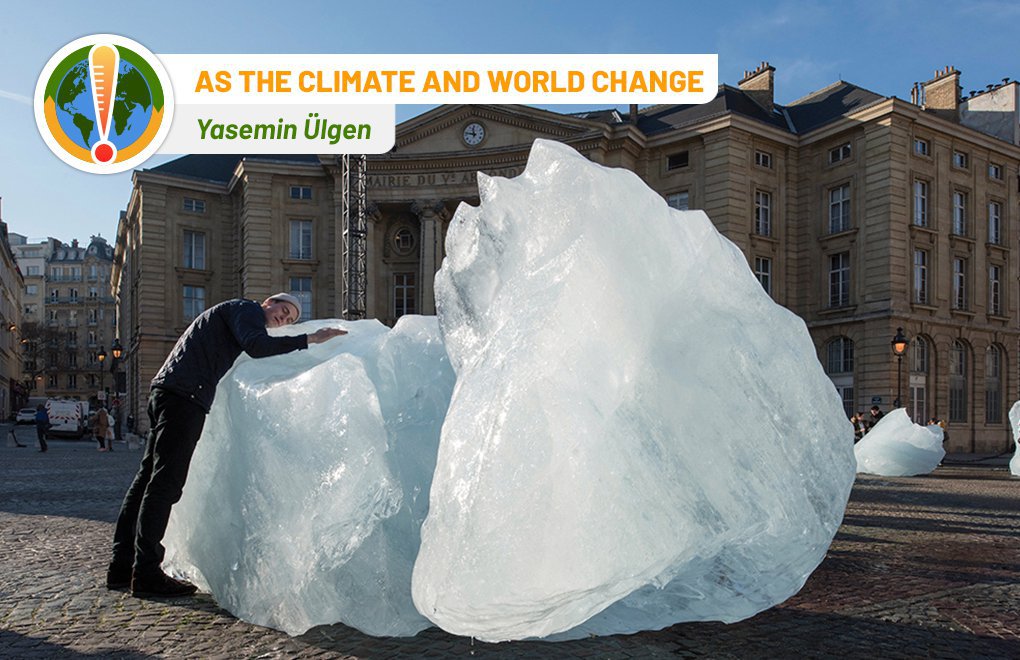
* Credit: Olafur Eliasson and Minik Rosing/ Ice Watch
Click to read the article in Turkish / Kurdish
"Welcome to 2021!
The world is hotter than ever and is warming faster than ever before.
The world is dirtier than ever and is getting polluted faster than ever before.
Trying to grow unlimitedly with limited resources,
We pollute unlimitedly with a limited sink.
We have crossed the line; we are going to extinction.
We do not know if the end of humanity will come, but we can predict the end of human, animal and natural rights."
-birbuçuk
In today's world, where the human impact on the Earth is at a high level, the climate issue, which requires urgent struggle, is on the agenda of nearly all fields.
Despite the increasing warnings of science and the field of struggle, the system continues to bring itself into an inextricable situation. The fact that people see nature as a source of energy and raw materials for the continuity of the existing socio-economic structures in the system and take it under control has brought the earth into this critical period that causes and will cause irreversible changes.
If we accept that multi-layered and complex production and consumption relations have caused this transformation, might we need an approach that brings together scientific knowledge, the experience of the struggle, and the creativity of art in the struggle for ecology?
The 1990s and 2000s
Situations and transformations created by the changing economic and political systems on a local and international scale after 1990 affected the content of the productions of the artists.
In these years, identity, belonging, individual, migration, and class differences, which were also the main focus of social sciences, were the main issues of the artistic productions. Locality, rural-urban relationship, images, stories, or originalities produced by geographies shaped art.
After 2000, ecological issues also became the main subject of many artists. In these years, the artists' original productions on the subjects of climate, Anthropocene, sustainability, ecology, nature-human relationship, and the third nature draw attention.

16-week performance where Lucienne Rickard first draws and then erases extinct species. Credit: Jesse Hunniford
Transforming cities
The projects of unearned income implemented within the scope of Turkey's economic growth programs, especially in the last fifteen years, have considerably changed the definition, function, and representation of urban space. In this sense, the city and space can be considered one of the most critical contexts in climate discussions and artworks produced in this field.
The social, economic and political relationship of cities' different scales that stem from their structure is of crucial importance. The inequality and injustice that burst in the cities and non-urban areas bring about new and complex relations between society and nature.
Today, cities -within their set physical boundaries- are perceived as structures that are independent from the countryside. However, when examined at micro and macro levels, it can be argued that its boundaries are melting, and their relations are changing and transforming day by day.
Cities' boundaries becoming blurred
Although cities cover 2 percent of the world in terms of area, it is getting harder and harder to determine the starting and ending points of city borders when the production-consumption processes are considered.
As individuals living in the city, we generally define nature as areas experienced temporarily outside reinforced concrete. However, it should not be forgotten that the city and nature are intertwined.
The structure of the city transforms nature but cannot capture it as a whole. On the contrary, nature always shows its existence by infiltrating or destroying these controlled designed areas.
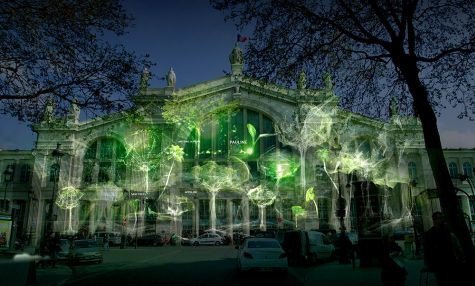
Naziha Mestaoui- Virtual Forests
Unable to meet needs
Nature exists in the city through the water flowing from the tap or the "invasive" grass emerging from the ruins. However, the problematic side of the city is related to how it meets its needs.
Today, concrete cities, whose soil and water resources have decreased to such an extent that they can upset the balance of nature, cannot meet their needs within their borders and exploit the resources available in the countryside.
All the resources that ensure the continuity of the city- from the food that comes to the table to the drinking water, from the energy of the big shopping centers to the raw materials of the construction sector- are beyond the limits of the city. This situation makes cities dependent on rural areas.
Due to this dependent structure, every resource we consume as individuals living in the city and every waste we produce is related to the nature of the city and outside the city. These relationships cause a series of social transformations.
Climate struggle in Turkey
Increasing climate disasters, the policies of the government, and the climate struggle in Turkey have further triggered the debates in this period. Various organizations and independent bodies have been very influential in the spread of these debates.
Food cooperatives, various public events, calls to action, meetings, platforms, festivals, or academic publications that contain ecological information and practices foster the struggle for ecology.
Impact on contemporary art
While climate is the subject of daily life, it also affects the production processes of different areas. One of these fields is contemporary art.
Some of the productions in contemporary art in Turkey deal with and point out the issues of the climate struggle or directly contribute to it.
Every day, topics such as water, soil, biodiversity, food, culture, metabolism, borders, climate, mining, gender, energy, waste, and the city are added to the agendas of artists, art workers, or institutions.
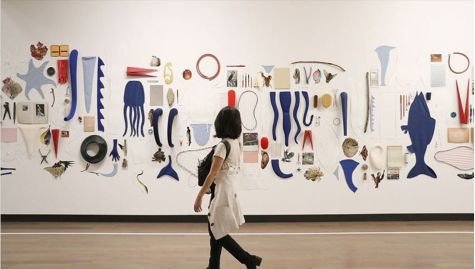
16th Istanbul Biennial. Credit: AA
A cultural problem
Today, in contemporary art, it is possible to encounter many productions that point to these mentioned issues, visualize them, or open them up for discussion. According to ecocriticism, environmental problems are cultural and political situations as well as scientific cases and should be studied in this context.
Such cultural studies are carried out by utilizing the knowledge of different disciplines, just like political ecology studies. These studies, which require knowledge of art-culture theory, philosophy, sociology, psychology, environmental history, and ecology, are instrumental in looking at climate issues from different dimensions.
Drawing attention to the urgency of the critical period the planet is in through various forms, the artists drew attention to the uncontrolled consumption of natural resources and the unjust destruction of people and non-human beings, ecosystems, communities, cultures, and social relations.
Reactive artworks
Especially in the 1960s, the visual arts were important in the cultural context because of producing unique associations with struggle. While the artists criticize the marketization of art and the structures of galleries and museums, they also performed reactive artworks that consider the system in an ecological context and define nature as a political discussion area.
The works of the artists such as Robert Smithson, Walter De Maria, Dennis Oppenheim, Michael Heizer, Nancy Holt, James Turrell, Carl Andre, Eva Hesse, Lynda Benglis, Robert Morris, Richard Serra, Alan Sonfist, Agnes Denes, Mark Dion, Mel Chin, and Mierle Laderman Ukeles became a reference to the works produced in Turkey in the ecological context.
Collaboration with the communities
Suggesting innovative and interventionist approaches, the artists draw attention to the dangers posed to the life and health of human and non-human beings, the causes or social transformations that will lead the world's ecosystem to collapse.
In doing so, they cooperate with experts in different fields such as ecologists, botanists, architects, engineers, zoologists, social scientists, local people living in the region, or people and communities who take an active role in the struggle.
The fact that they are working with people from the scientific field does not mean that the artists are looking for definitive answers. These artistic productions are new forms that are inspired by the knowledge of different disciplines or contain this information and emerge from the artist's relationship with the world.
Of course, these forms can be instrumental in the emergence of new tools for thinking, discussion, and action; they can create different types of relationships and spheres of influence. Although these forms do not produce a direct political discourse most of the time, they can bring together people who can influence politics and contribute to the process of struggle, albeit indirectly.
Beyond the city limits
It can be argued that the climate struggle, which has been on the rise in big cities such as Istanbul, Ankara, and Izmir in recent years, is similar to contemporary art. Even though both are the practices experienced in the city, they focus on issues that go beyond the boundaries of the city.
The mentioned fields of art and struggle develop responsibility towards the current political processes with which they are related and exhibit an interdisciplinary and holistic approach rather than a single language of expression.
Contemporary art, which offers new perspectives and social relations to the audience, can point to the discourse of social struggle with a creative language. Although it is not a tool at the political level, it can open new discussions on the subject, become a representation of the struggle, and contribute to it by bringing together people who can influence politics.
Today, contemporary art appears as areas of political experience infiltrating daily life in public spaces, allowing participation, association, and interaction, as well as being displayed in sterile exhibition spaces such as galleries and museums.
The focus of the audience
As a result, Anthropocene, climate, and ecology issues in contemporary art productions have become the focus of collectives, institutions, and art audiences, due to the increase in environmental problems and the parallel struggle in Turkey, especially after 2000.
The mentioned titles have become the priority of every field, from independent exhibitions to biennials, from events organized by art institutions such as museums and galleries to festivals organized by local governments.
A comprehensive example of current academic studies in this field is the Istanbul Unbound: Environmental Approaches to the City conference held on April 8-11, 2021, in partnership with the Istanbul Research Institute and Pera Museum.
Academy, struggle, and art
This conference brought new approaches to the urban landscape of Istanbul, discussed the relationships of Istanbul's people, non-humans, and the environment with contributions from environmental history, political ecology, and contemporary art.
The 29.9 km video program, organized by birbuçuk within the scope of the conference, can be considered as an example that brings the fields of academia, struggle, and art together.
The ten different contents included in the video program were produced online under pandemic conditions by artists, people who took an active role in the climate struggle, and academics.
Focusing on the history, culture, wildlife, metaphors, symbols, and ecological transformations of Istanbul, the videos explore the city within the framework of political ecology, while also pointing out the striking contrasts within- and opening a series of concepts for discussion.
Now is the time to look for creative ways
Today we have crossed many borders. The fight for climate is the priority of us all, from the local to the global. All these discussions, narratives, and information are so valuable for re-establishing the future.
Now is the time to look for creative ways to be together and side by side so that differences turn into commonality. As I mentioned, although art productions do not produce a political discourse, they are a creative tool to bring together people who can affect politics, contribute to the process of struggle, expand the horizon, and produce micro-narrative spaces.
(YÜ/SO/EÜ/SD)
"As The Climate and World Change" article series*
Our life becomes history while we live! - Ömer Madra
1/ A country outside of the global climate policy: Turkey - Ebru Voyvoda
2/ Climate change, securitarian policies and ghosts - Özdeş Özbay
3/ Turkey's energy policy: Indigenous at home, Blue Homeland in the world - Emre İşeri
4/ The impact of climate crisis and fossil fuels on child health - Çiğdem Çağlayan & Funda Gacal
5/ We will see beautiful days, coal-free and sunny days - Elif Ünal
6/ Either capitalism or the future - Tuna Emren
7/ The three pillars of climate journalism: Science, politics, and social justice - Ece Baykal Fide
8/ Bringing science, struggle, and art together - Yasemin Ülgen
9 / Clean energy or betrayal? - Serkan Ocak
10 / It is time to say stop economic growth - Fikret Adaman & Gökçe Yeniev
11 / When climate refugees knock on our door - Mehmet Mücteba Göktaş
13 / Climate crisis affects women, women affect climate struggle - Merve Özçelik
14 / Climate fiction in literature- Buket Uzuner
15/ Dr. Faustus and children in the age of fire- Ömer Madra
* This series of articles is published with the financial support of Oslo Metropolitan University (OsloMet) Journalism & Media International Center.






